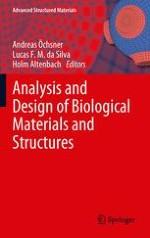Abstract
Stress distribution in the arterial wall has been shown to be associated with several vascular disease, e.g., atherosclerosis and abdominal aortic aneurysm (AAA). The variation of material properties of the vascular wall is related to the local onset of disease, which leads to the alterations of stresses and strains that provide essential clinical information. We therefore investigate the distributions of stresses and strains in a longitudinal, heterogeneous arterial wall under physiologic loadings. Four Models were analyzed: Model 1 was the idealized Young’s modulus for normal aorta, Model 2 was the idealized Young’s modulus for pathological aorta, Model 3 was the actual Young’s modulus for the normal aorta, and Model 4 was the actual pathological (AngiotensinII-treated) aorta. The arterial Models were assumed to have idealized geometry, i.e., axisymmetric, uniform, cylindrical, purely elastic. In Model 1, we assumed the wall material to be homogeneous, i.e., described by its Young’s modulus equal to 150 kPa. One stiff inclusion was defined at the middle part of Model 2, by changing its Young’s modulus 150–550–150 kPa. The local Young’s moduli, which are experimentally estimated from our previous study, in Model 3 and 4 were equal to 140.8 ± 10.2 and 1676.8 ± 926.0 kPa, respectively. Stress and strain calculations in all cases were performed using a finite-element method. The transmural stress and strain decreased toward the outer wall uniformly in Model 1, i.e., stress ratio was equal to 133.3%. But the stress dramatically increased at the boundary of stiff-soft region in Model 2, i.e., stress ratio was equal to 187.0%. While the trends of stresses and strains in Model 1 were uniform longitudinally, sharp-increases of stresses in Model 2 were found at the boundaries between high and low Young’s moduli, i.e., 25% higher of the adjacent sections. Model 3 and 4 have depicted similar stress and strain trends as Models 1 and 2. However, Model 3 is not perfectly homogeneous, and thus slight increases stress in axial direction, and an even higher number of such increases were found in Model 4. This is because of the longitudinal change in material properties that cause changes in the stress and strain distribution. These stress discontinuities may indicate a higher risk for rupture in the affected area. A feasibility study was thus shown for monitoring suspicious wall regions that may be more prone to disease due to their higher heterogeneity.
